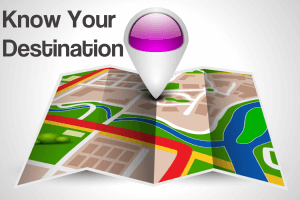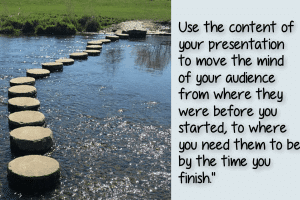Presentation Skills – The Gentle Art of Moving Minds
Why do we find people with well-developed presentation skills so captivating?
What do the great orators of the past, the compelling media presenters of the TV era and great entertainers have in common? I believe that the answer lies in their ability to challenge our thinking. They understood that the art of public speaking is a means to an end and that end lies in the minds of their audience.
Sadly many ineffective speakers don’t get this. They are so wrapped up in their world that they fail to realise that the only real measure of how good your public speaking skills are is whether the people in your audience think, feel, and act differently after having listened to you.
 Presentation Skills Tip 1 – Start where your audience are
Presentation Skills Tip 1 – Start where your audience are
I find the metaphor of a journey to be very helpful when it comes to creating and delivering an effective speech. A presentation is like a journey because, if you get it right, you are moving your audience’s thinking from one place to another.
Every journey has a starting point and a destination. In the context of a presentation, that departure point is what your audience think about the subject of your speech. For example, they might be unconvinced or sceptical or even hostile, or they might be open, curious, or even eager to know more.
- Do you know where our audience are at?
- How could you find out?
Acknowledging where your audience members initial attitude towards your topic is one of the most important presentation skills because it allows you to build rapport quickly. Not convinced yet? Neither was I when I first heard this, so consider these two scenarios.
The context:
Imagine that you are listening to a presentation, at work, about the upcoming roll out if a supposedly super-efficient new IT system. The problem is that the last time a change like this happened, it caused chaos.
Scenario one:
The speaker launches into a high-energy, upbeat presentation of all the amazing things this new system will do without making any reference to the problems of the earlier system. The more you listen, the more their speech sounds like the presentation used to “sell you” on the current system that you now hate so much.
Scenario two:
The speaker starts by empathizing with you, using words like “Now I know that many of you have serious doubts about the introduction of another system. Our current system, which we all find so frustrating, was also promised to be an all singing, easy to use IT system and it failed to live up to its promises, so why should this new one be any better.”
I don’t know about you, but I can just see the people in the audience nodding and saying to themselves “Too right!”
Next, the presenter goes on to outline how the project team has learned lessons from the problematic introduction of the current system. They show you how they developed the new software with the advice of end users just like you. Then they demonstrate how it eliminates the most annoying features of the current system. Can you feel your resistance starting to defuse?
It’s all too easy to ignore the reality of where your audience are at, particularly when you feel that it is hostile or negative, but ignoring it won’t make it go away! Acknowledging their concerns is the first step towards winning the trust and respect of your audience.
Presentation Skills Tip 2 – Know your destination

Having established rapport by acknowledging where your audience members are at, the next thing you need to do is lay out a compelling destination. Sadly many speakers miss this step. In fact, I have come to realise that for most presenters, their default destination is survival! They just want to get through the presentation without making a fool of themselves, and anything else is an unexpected bonus.
They just want to get through the presentation without making a fool of themselves! Anything else is an unexpected bonus.
While it’s understandable, and we have all been there, I hope you can see that it isn’t a great recipe for a genuinely successful speech. Once again, it’s the result of focusing in on yourself and not your audience.
Before you start to write your speech, you should start by thinking about where your audience are before you start to speak (A), and where you want them to be after you have finished (B).
Only when you can answer these two questions confidently, can you go about planning what you need to put into your presentation to ease that mental shift from A to B. Only then can you use your other presentation skills to build and deliver a compelling case.
Presentation Tip 3 – Change their minds one step at a time
Now, you can plan the main body of your presentation. These are the facts, evidence and stories (case studies) that will help shift your listeners attitude. I often think of them as stepping stones across a river. You can’t expect them to leap across, but, if you present them with a logical sequence of small steps you can achieve your objective.
For example, if you suspect the audience are initially hostile to your idea, your first stepping stone may be to be open to the possibility that that your idea might just have some benefits. The next step might be to get them curious to find out more, and so on.
Does any of this strike a cord with you? Can you see how you could use these ideas to improve your presentation skills? Use the comments box below to share your own ideas or to ask additional questions. I’d love you hear from you.
 Presentation Skills Tip 1 – Start where your audience are
Presentation Skills Tip 1 – Start where your audience are



